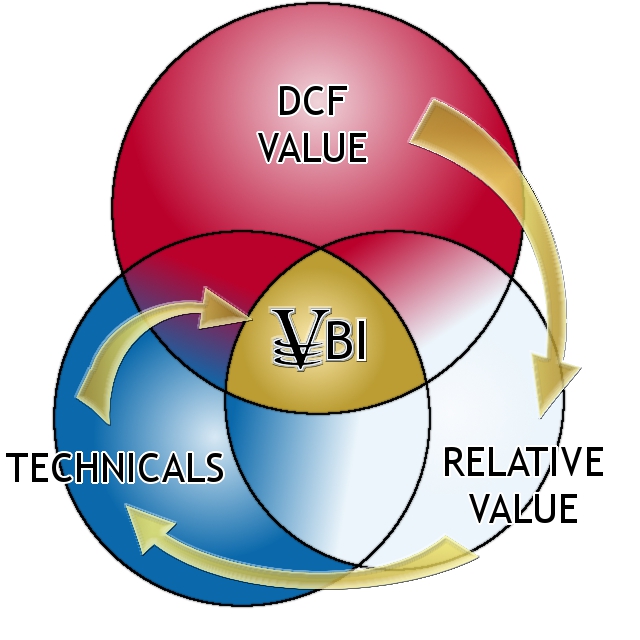Member LoginDividend CushionValue Trap |
Third-Level Thinking and "Keynesian Convergence"
publication date: Oct 5, 2020
|
author/source: Brian Nelson, CFA
Image: The analytical process of the Valuentum Buying Index rating system. By Brian Nelson, CFA In the 2011 book, The Most Important Thing, co-founder of asset management firm Oaktree Capital Management, Howard Marks, divided stock market analytics into two levels of thinking, first-level and second-level. Marks used a few examples to explain the difference between these two levels of thinking:
First-level thinkers may buy a stock because they like the quality of the business but they may fail to incorporate second-level thinking that captures the future expectations that are embedded into the price. On the other hand, second-level thinking not only considers the quality of the business, but also the expectations embedded into the price to determine whether an investment is a good one or not. For example, a less-than-ideal business can be a great bargain at the right price, while an excellent business can be a terrible investment at the wrong price. We see this dynamic come into play with respect to Morningstar's analysis of moat ratings, where no moat stocks have outperformed narrow moat stocks, which in turn have outperformed wide moat stocks over the 15-year period ending 2017. Buying a great business at the wrong price can sometimes be a painful proposition, while buying an underappreciated company with mediocre competitive advantages could lead to a huge payoff if the mispricing is large enough and a margin of safety is sufficient. The price versus fair value estimate analysis captures second-level thinking. But there's more levels of thinking, too. British economist John Maynard Keynes used the analogy of a fictional newspaper beauty contest to explain how the market operates in his 1936 book, The General Theory of Employment, Interest, and Money. To win a prize, the entrants must choose the most popular faces in the contest. A simple strategy might be to select the faces one thinks are most attractive, while a more advanced strategist might envision what the majority might think are the most attractive faces--while still a more sophisticated strategy might consider each entrant's opinions of what the majority perception of attractiveness might be.
In today's ultra-competitive stock market environment, where fewer and fewer professional investors are outperforming, even a reliance on second-level thinking that considers both the quality of the business and the price-versus-value equation may not be enough. This is where third-level thinking comes into play, or anticipating changes in what the market might think the true fair value of the equity might be. Let's try the following example to get to third-level thinking.
That's what Valuentum investing targets, third-level thinking. We wholly embrace second-level thinking through a robust price versus intrinsic value process with a fundamental long-term basis, but we also layer on third-level thinking, too, by capturing the market's perception of valuation through relative multiple analysis as well as the market's opinion of the trajectory of a company's value by assessing technical and momentum indicators (an increasing price generally indicates that the market thinks the company is worth more). In today's ultra-competitive market environment, successful investors have to embrace third-level thinking. Perhaps a term that we're defining here, "Keynesian convergence" is the process that occurs when a strong company that is underpriced relative to an estimate of its intrinsic value just starts to begin its price-to-fair value convergence--when the market starts to recognize its underpriced nature. This is the area where third-level thinkers operate. It's not enough just to identify strong companies that are undervalued, as in second-level thinking--you could still fall into value traps! Overlaying technical and momentum indicators to bolster the likelihood of price-to-fair value convergence further enhances the probability of success. After all, for a stock to converge to an above-market intrinsic value estimate, it first must start to advance. Why catch a falling knife, or a superficially undervalued stock that keeps going down in price, when one can wait until the stock's technical and momentum indicators turn first? At Valuentum, we seek to identify strong, competitively-advantaged companies that are underpriced [with solid cash-based sources of intrinsic value (net cash, strong expected free cash flows)] whose share prices are either 1) also advancing, 2) have strong relative pricing strength, or 3) have just started to begin to advance toward an intrinsic value estimate (with a nice growing dividend to boot, where applicable). Third-level thinking is our foundation at Valuentum, and it continues to serve investors well. --- Kind regards,
---
Brian Nelson, CFA
President, Investment Research
Valuentum Securities, Inc.
brian@valuentum.com
It's Here!
The Second Edition of Value Trap! Order today!
 ---
----
Tickerized for holdings in the DIA.
---
Valuentum members have access to our 16-page stock reports, Valuentum Buying Index ratings, Dividend Cushion ratios, fair value estimates and ranges, dividend reports and more. Not a member? Subscribe today. The first 14 days are free.
---
Brian Nelson owns shares in SPY, SCHG, DIA, VOT, and QQQ. Some of the other securities written about in this article may be included in Valuentum's simulated newsletter portfolios. Contact Valuentum for more information about its editorial policies.
|



2 Comments Posted Leave a comment